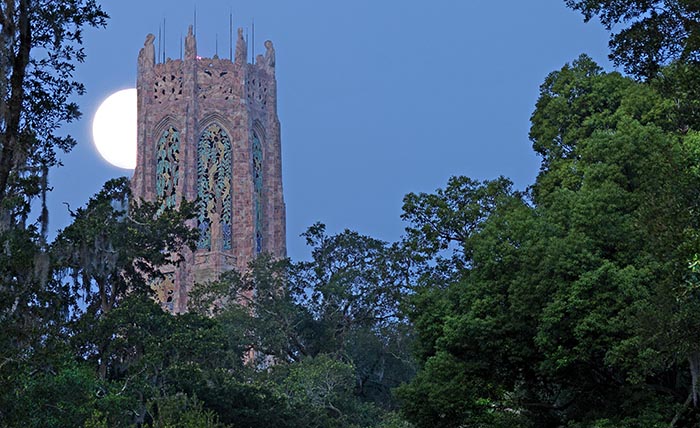
It’s six in the morning and the sun is breaking the horizon atop Iron Mountain. The morning dew settles, hugging the Spanish moss draped over the limbs of oak trees. Swans glide along the pond and rabbits dart in and out of shrubs.
This scene wasn’t plucked from the pages of a fairytale. It’s from Bok Tower Gardens, a place where serenity is so strong it reverberates through the soul.
Located approximately 55 miles east of Tampa, Bok Tower Gardens was created by Edward Bok, a Pulitzer Prize-winning author and humanitarian. A national landmark, it has offered inspiration and spiritual enrichment to more than 23 million visitors since its completion in 1929.
Bok fell in love with the beauty and dramatic sunsets of Iron Mountain, one of peninsular Florida’s highest points, during visits from Pennsylvania to his winter retreat in the Mountain Lake community. After purchasing multiple residential properties, he commissioned several world-renowned craftsmen to create a landscape garden, a Singing Tower with a 60-bell carillon, and a haven for birds, plants and wildlife.
Bok said his goal was to create a place that would “touch the soul with its beauty and quiet.” The end result, Bok Tower Gardens, is considered by some to be among the nation’s most inspiring and uplifting attractions, one where time seems to stand still.
On Feb. 1, 1929, President Calvin Coolidge dedicated the Gardens.
He called it Bok’s gift to the American people.
Samuel Yellin was hired to design the metal and ironwork on several elements of the tower, including the great 1,000-pound brass door. Yellin’s piece has 30 panels depicting the Biblical story of creation from the Book of Genesis, starting with the creation of light and ending with Adam and Eve being banished from the Garden of Eden. Bok, who died in 1930, is buried in front of the door at the base of the steps.
Before the tower was built, Edward Bok wanted Iron Mountain transformed from a sand hill into one of the nation’s most beautiful garden sanctuaries. He enlisted the most distinguished landscape architect of that generation, Frederick Law Olmsted Jr., for this duty. Olmsted Jr. worked diligently to combine native and exotic plants that would thrive in the climate while lending a tropical feel to the landscape’s oak forest.
Overlooking much of Lake Wales, it’s considered a great privilege to climb the stairs leading to the tower’s peak. But it’s not for the faint of heart, or claustrophobic. The 1928-crafted Otis elevator takes visitors to the carillon room and balconies located up about three-fourths of the way up. The roof, however, is an extra hundred feet higher, up several twisting staircases. It’s closed to the public, but some membership levels permit travel to the top.
Famed Philadelphia architect Milton B. Medary was hired to design the 205-foot art deco and neo-Gothic inspired carillon tower. A combination of coquina from St. Augustine, Fla., and pink and gray marble from Tate, Ga., was used to design and build the tower. Lee O. Lawrie created the sculptures. The New York native was moved by Florida’s natural landscapes, but he also drew inspiration from nature-based symbolism and stories in Greek mythology and the Bible. Photographer Gabriel Burgos took this panoramic shot of the tower’s roof and its walking platform.
Sixty bronze bells weighing from 16 pounds to 12 tons each elicit the sound that comes from the Tower’s Taylor carillon, made in Loughborough, England. It is one of only four carillons in the state.
In the Bok Gardens, something is always in bloom. Among its many resting spots, shady recesses, sweeping lawns and meandering paths, there are acres of flowering foliage, such as camellias, azaleas and magnolias.
The carillon plays concerts at 1 p.m. and 3 p.m. daily and brief digital performances fill the garden every 30 minutes. A keyboard and pedalboard are connected between key and bell clappers that respond based on the amount of force applied. William De Turk is the current and third carillonneur at Bok Tower Gardens.
Reminiscent of the early 1930s, Pinewood Estates is a 20-room Mediterranean-style home that allows guests of Bok Tower Gardens to go back to Edward Bok’s era and experience the illustrious lifestyle of C. Austin Buck, an early 20th Century industrialist. The sanctuary purchased the home in the 1970s. Guided walking tours are available daily.
“This is nature’s show, not ours,” reads a sign outside the Window by the Pond observatory. To fully enjoy the garden’s beauty, one only needs to sit still long enough to smell the grass, listen to the wildlife or stop and smell the flowers, like this one found in the endangered plant garden.
The Bok Tower Gardens conservation program showcases more than 30 of Florida’s rarest plants. Partially funded by the U.S. Fish & Wildlife Service, it has living plants and seeds collected for research, education and to serve as a buffer against extinction. President of Bok Tower Gardens David Price says they may be “plants only a botanist can love,” but their stories are very intriguing.
Native to Mexico, the Century Plant is a member of the genus Agave and produced a 30-foot stalk in May. The plant, which despite its name does not take 100 years to bloom, chooses its own time to use all of its energy and create a once-in-a-lifetime stalk. This 16-year-old plant will release small blooms of white or yellow flowers and die.
Before C. Austin Buck built his home, which is now the Pinewood Estate exhibit, he hired landscape architect William Lyman Phillip, from the same firm as Frederick Law Olmstead Jr., to design a sanctuary garden. While it may seem odd to build a garden before a home, Buck, like Bok, admired the area’s longleaf pines and other native plants. Philip and architect Charles R. Wait collaborated on this home, as well as many other residences in neighboring Mountain Lake Estates, which is a gated and closed to the public.